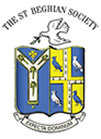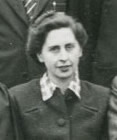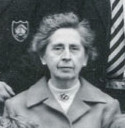|
 |
The Old St Beghian | |
| July 2021 | |||
Charles Hedley (FN 58-64) has contributed the following:
Margaret Widdas - a very belated tribute.
“Anyone who was at St Bees School during the time when Margaret Widdas was on the staff, and who didn’t have art or music lessons from her, might be excused for not knowing who she was as she went about her teaching commitments in her typically quiet, purposeful and dedicated manner. She was a member of staff for approximately 45 years.
She was born in Cleator Moor in 1911 to Henry and Marion Widdas, and at that time Henry was employed by Lord Lonsdale with responsibility as the Mines Inspector for the Whitehaven Castle Estate, in the days of private mine ownership and long before the nationalisation of the coal industry in 1947. Mining runs like a rich seam (pardon the dreadful and unintended pun) through the Widdas family. Two of Henry’s elder brothers, his father and grandfather, were all part of the mining inspectorate and management. His nephew Walter had a very distinguished career in the industry, and was awarded the CBE in the New Year’s Honours list of 1965. In that same year he was also President of the Northern England Institute of Mining and Mechanical Engineers. His two sons, Michael and Christopher were, like their father, also at St Bees and both had careers in the mining industry. Michael subsequently became President of the NEIMME from 1981/2. And so - the mining industry has been served by at least five generations of this family, which is an amazing record by any standard!
My reason for writing this tribute is because I am distantly related to the Widdas family, in that my mother’s grandmother was a Widdas. By pure coincidence my father was an exact contemporary of Walter’s at St Bees (only two weeks separated their birthdays); they played on the same rugby team, were on the same house (Foundation), but neither could possibly have imagined that years later in 1935 they would become related when my father married a descendant of the Widdas family.
This family connection was to become most advantageous. Michael Widdas (or Mick, as he was always known) began life at St Bees in 1949, and must have been invited to the odd Sunday afternoon tea at his Aunt Margaret’s. From that time, and in a steady procession, various cousins followed the same path to Whitehaven - R.J. Hedley (1950), J.N. Hedley (1951), J.D. Hedley (1952), C. Widdas (1957), C.A. Hedley (1958), M.A. Hedley (1959), R.M. Hedley (1963).
Taken from 1946 Whole School PhotoAs you can see, many Hedleys did benefit greatly from this distant family connection, and we all have happy memories of those Sunday afternoon teas, which happened two or three times a term. Tea was always made with filtered rain water from a cylindrical ceramic Permutit water softener and then served up in a silver tea pot. Actually, I don’t think that the water needed softening any further because Whitehaven water is already soft, but Margaret wanted to eliminate all possible impurities from her drinking water. The teas were wonderful occasions - superb food, plenty of it, and in luxurious surroundings. I don’t know how she managed it - feeding hungry teenagers, sometimes four at a time! The food was all home-made and she must have spent ages in its preparation. There was also the luxury of sitting on upholstered furniture for a brief spell, before we all returned by bus to the Spartan life on Foundation with its hard wooden benches.
In her day Margaret was quite a sportswoman - good at tennis, squash and golf - and for many years she cycled from Whitehaven to St Bees to fulfil her teaching commitments. She did this journey on what she called her ‘Flying Flea’ - a very early form of motorised bicycle, which incorporated a petrol engine in the back wheel. It must have been quite a machine because whichever route you take out of St Bees, a significant hill is encountered. Eventually, as she lived close to the Corkickle railway station, she did this journey by train.
Music was her life. She studied piano at the Royal Academy of Music in London, gaining her LRAM qualification, and began teaching at St Bees in 1936 at the tender age of 25. Apart from a few years during WW2, when she worked as a nurse at Whitehaven Hospital, she continued teaching music and art at school till 1984. Quite apart from her St Bees pupils, she taught numerous private pupils to all levels on her much-admired Blűthner (or was it a Bechstein?) grand piano at her home. She established a musical relationship with the examiners from the Associated Board of the Royal College of Music, who used her home as an examination venue for an appreciable period of time. For many years she regularly booked herself a series of concerts at the Edinburgh Festival, so she could listen to world class musicians and orchestras. I think that these might have been in the days before the ‘Edinburgh Fringe’ type of entertainment became so popular. Somehow, I can’t see that the Fringe would ever have been her comfort zone! She was also a very regular supporter at the Rosehill Theatre, just outside Whitehaven, which opened in 1959 and where international soloists and ensembles performed, and still do today. As a season ticket holder, she always sat in the same single seat upstairs in the front row at the right-hand side - ‘her’ seat!
As well as her piano teaching at school, Margaret was also responsible for painting scenery for the various drama productions. In the mid 1950s, and in partnership with some members of the National Youth Orchestra, a fully staged production of ‘Ruddigore’ was performed in the Memorial Hall. Margaret’s artistic contribution to this event was considerable, in that she painted the seven full-length portraits of former baronets of Ruddigore which feature so dramatically in this Gilbert & Sullivan operetta.
She never married, and cared for her parents at home till they died – Marion in 1951, and Henry in 1957.
Away from music and in her spare (?!) time she was a very keen organic gardener, and was totally convinced of the practice of sowing and planting according to the phases of the moon. The results were impressive, and she grew a small plot of comfrey, which she used both as part of her composting system and also for medicinal purposes. Many people probably consider comfrey as little more than an impressive invasive weed usually found in the hedgerows, but in Margaret’s garden the leaves would be collected, carefully dried and then crushed into a grey-green powder which she would then incorporate into her food. I don’t think she fed us any, but we will never know! She was also totally convinced of the benefits to be derived from drinking carrot juice – to the extent of her being able to tell whether one piano pupil had been drinking enough carrot juice by the quality of his piano playing. Apart from the advantages regarding piano playing, Margaret was also convinced that drinking carrot juice would help in dealing with acne! I only became aware of this recently when a certain person - a contemporary of mine at St Bees, and who shall remain nameless - was good enough to help me in my quest for information for this article. He also told me that he was perhaps not so keen as he might have been in pursuing his piano studies and so hit upon the idea of faking a rugby accident. This meant that his hands had to be bandaged and naturally meant that he was unable to practise, so avoiding piano lessons. This seemed a good idea at the time and worked quite well until the end of term when inevitably his music report found its way into parental hands. He was then confronted by his mother (well-known socially to Margaret) who knew nothing of the rugby wounds or accident. Mother was not impressed and I don’t suppose Margaret was either!
From 1950 till 1964, with a gap of only two terms, my parents often stayed at her home when they came to visit me and my two brothers every term. There may have been some interesting conversations about the niceties of organic gardening as my father (himself a keen gardener) worked at I.C.I., which made vast quantities of artificial fertilizer on a global scale!
She did, however, have her own rather brutal ‘scorched earth policy’ which took the form of a wheeled paraffin flame thrower. She used this to wage war against any pernicious weeds brave enough to appear in her garden. Sometimes she subcontracted this activity to those hungry school boys mentioned earlier, while she prepared one of those fabulous Sunday afternoon teas. Great fun!
Margaret grew nettles for their nutritional value, incorporating them into her diet, which did seem to work well for her because she lived to the ripe old age of 91, and until her final years she always had an abundance of energy. Eventually, however, she found it increasingly difficult to live on her own at 6, Corkickle which had been her home for 40 years, and she was cared for by her friends Harold and Glenda Leach at their Scotch Street address in Whitehaven. She very much enjoyed her wheelchair outings around the town, and in the week before she died she attended an open-air concert by the Royal Liverpool Philharmonic Orchestra near the harbour, and also gave her last piano instruction to one of her pupils. Right up to the end then, Margaret’s life was lived with music around her.
Her funeral in 2002 was held at St John’s Church, Hensingham, on the south-eastern outskirts of Whitehaven where for many years she had been the organist, and it was to this church that – fittingly - she offered her much loved grand piano. Sadly, and because of space considerations, this offer had to be declined. It was a large piano!
Margaret had strong views about most things, and so there was never any doubt as to what she thought on a whole range of topics ranging from the finer points of musical phrasing right through to homeopathic remedies, taking in organic gardening on the way. I was lucky enough to have piano lessons from her for six years, and to this day I still try to play pieces she taught me to the best of my ability and to the standard that I know she would expect of me.
I shall always be grateful for her expertise and guidance in the art of piano playing.
That surely closes the book on Margaret Widdas! However - please bear with me - I recall that back in 1994 I did a solo sponsored bike ride and cycled from here at Whitley Bay across to St Bees on the road (via Newcastle, Hexham, Alston, Penrith, Keswick, Whinlatter, Fangs Brow, Lamplugh, Egremont) because the C2C Cycle Route had not quite been invented then. The weather on that day was very good, but after staying over-night at Margaret's home, and following a large breakfast, I cycled back home the next day. I think the rain started in the Loweswater area and just carried on all day. Cycling up Hartside in the rain and mist was not the most enjoyable experience!
I should mention - perhaps - that on the return ride home, my long-suffering and non-cycling wife Gill did meet me at Keswick and provided the back-up support (chocolate biscuits etc) at intervals for the rest of that incredibly wet day.
I must have been mad! And I was quite a bit younger as well (just before my 50th birthday!). I did have the next day off work as a holiday.
As you might imagine, it does make me smile a bit to read of cyclists taking three days to do the single trip. Probably a better idea, when all said and done.”
Home
The St Beghian Society
St Bees School,
St Bees, Cumbria, CA27 0DS.
Tel: (01946) 828093 Email: osb@stbeesschool.co.uk
Web: www.st-beghian-society.co.uk
![]()

